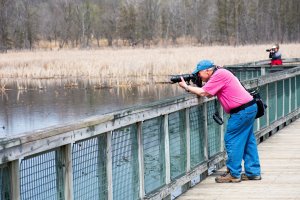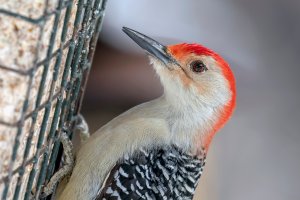Resolve to See More Wildlife in 2024
December 27, 2023
By Erin Parker, Interpretive Services Supervisor
Wrapping up the end of one calendar year can be a great time to reflect on the previous twelve months and look ahead to the next. What went well in 2023? What would you like to see more of in 2024? If one of the things that you’d like more of in your life is wildlife, build that into your goal-setting for 2024.
Get outside
One of the best ways to observe more wildlife is to spend more time outdoors. Your Metroparks, spread across 5 counties and consisting of 25,000+ acres, offer many options for wildlife viewing. Trails are open year-round and each season brings new wildlife experiences.
While outside exploring, keeping quiet and staying on the trails can be beneficial for both your experience and for safely watching animals without disturbing them. Look for tracks, scat, animal trails, nests, and other signs that animals have been nearby. Trails near each of the nature centers are dog-and-bike free to allow for quiet observation and photography. These are also areas where wildlife may be more active due to the lack of dogs and wildlife encounters may be more likely.

Consider the times of days that you are out exploring. Many of our resident wildlife species are crepuscular, meaning active at dawn and dusk. And even those that are diurnal (active during the day) may be more visible at twilight as park visitation drops down. Just like your household pets learn the routines of their humans, park wildlife are aware of the busy times of day for park patrons and may be leery of trails and other high-visibility areas during peak-people hours.
Try a new skill
Kayaking, canoeing, snowshoeing, cross-country skiing; all of these silent sports are good ways to experience wildlife, too, and allow you to gain new perspectives on the parks and the animals that inhabit them.
Learn to plant native plants that attract pollinators, birds, and mammals. This can draw wildlife to your property where they’ll find food and shelter.
Winter tree identification skills can help you locate trees that are more likely to host birds and other animals.
Try an art class- learning to see the natural world through the lens of watercolor or other art form can also help develop your senses for wildlife viewing!
Stay inside
If the weather or trail conditions aren’t ideal for you to get outside, there are many wildlife options inside, as well. Take a class or workshop or find a cozy chair overlooking the bird feeding areas from one of the interpretive centers. Put up a bird feeder in your own backyard or on your balcony and observe the birds from your kitchen table.

Community science projects such as Project FeederWatch encourage weekly data collection and its as easy as watching the visitors to your feeder for two consecutive days. Projects like this both encourage the individual participant to pay close attention to their backyard birdlife, it also provides scientists with a large pool of data about bird populations and feeder use. If weekly observations feel like too much of a commitment, try something like the Great Backyard Bird Count which takes place over one weekend in February each year. Data collected from birdwatchers provides a snapshot of birds at feeders across the continent. Not ready to collect this data on your own? Stop by a local nature center and learn more about bird identification and how to collect and submit data.
Your Metroparks offer many opportunities for guided hikes to seek out wildlife and develop your powers of observation. From learning the local birds to growing your photography skills- check out all of your options at metroparks.com! Wildlife experiences for all ages can be found on our events calendar, under the Things to Do heading on the website.
Wildlife resolutions
Resolve to get out with a park interpreter in 2024 to increase your knowledge of wildlife and their habitats in our region or hit the trails with your family and friends and explore a new park or trail. Look for our 2024 Trail Challenge that encourages visitors to log miles on trails throughout all 13 Metorparks- a great way to get outside, see the parks, and seek out wildlife along the way!
